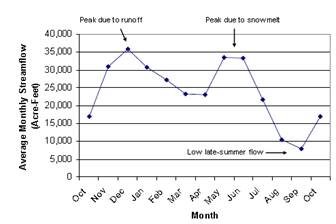Water Quantity
Water Quantity |
Low summer stream flows may limit supplies of clean water for people and fish in summer months in WRIA 16 and 14b. Water supply appears adequate in the short term, but more data are needed to assess expected future quantities and needs and to determine whether low summer flows impair fish habitat. Stream flows are lower in the summer, and additional analyses may be needed in some sub-basins to determine whether these lower flows are adequate to protect fish habitat and other uses the streams support. In addition, current data are insufficient to assess the continuity between ground and surface waters and to provide other information that would help process applications for water rights in the watershed. Water conservation would help avoid future water supply problems, particularly in high-growth areas such as the south shore of Hood Canal. Water conservation may also help mitigate the possible long-term effects of climate change and may be needed to help address low-flow concerns in summer months. Climate change may affect the timing and magnitude of WRIA 16 streamflows. The Watershed Team has addressed water quantity concerns in the watershed by:
|
Instream Flows |
The term "instream flow" is used to identify a specific stream flow (typically measured in cubic feet per second, or cfs) at a specific location for a defined time, and typically following seasonal variations. Instream flows are usually defined as the stream flows needed to protect and preserve instream resources and values, such as fish, wildlife and recreation. Instream flows are most often described and established in a formal legal document, typically an adopted state rule. For more information on instream flows, visit http://www.ecy.wa.gov/programs/wr/instream-flows/isfhm.html. The WRIA 16 Watershed Management Plan does not specifically recommend instream flows. However, the Watershed Team, the Department of Ecology, and the Skokomish Tribe will continue to discuss the steps leading up to, and including, this process. |
Additional Water Quantity Information: |
River & Stream Flow Monitoring http://www.ecy.wa.gov/programs/eap/flow/shu_main.html Measuring Water Use http://www.ecy.wa.gov/programs/wr/measuring/measuringhome.html Water Banking Water banking is an institutional mechanism used to facilitate the legal transfer and market exchange of various types of surface, groundwater, and storage entitlements. http://www.ecy.wa.gov/programs/wr/market/waterbank.html WA State Trust Water Rights Program This program provides a way to legally hold water rights for future uses without the water right relinquishing. http://www.ecy.wa.gov/programs/wr/market/trust.html |

 Average Monthly Streamflow in the Duckabush River 1938-2003 (USGS Gage 1205400, as reported in Golder Associates, 2003) The Duckabush River is an example of one of Hood Canal’s larger drainages with peak flows resulting from both winter rains and spring snow melt. Typically the lowest stream flows occur in late September and are almost entirely supported by groundwater.
Average Monthly Streamflow in the Duckabush River 1938-2003 (USGS Gage 1205400, as reported in Golder Associates, 2003) The Duckabush River is an example of one of Hood Canal’s larger drainages with peak flows resulting from both winter rains and spring snow melt. Typically the lowest stream flows occur in late September and are almost entirely supported by groundwater.